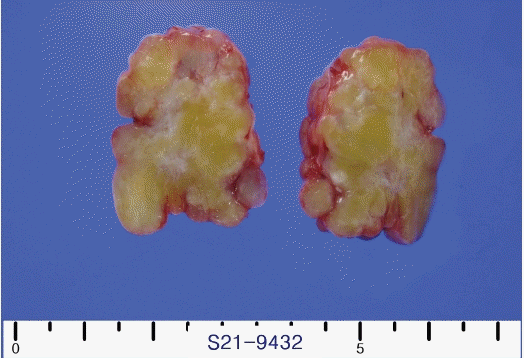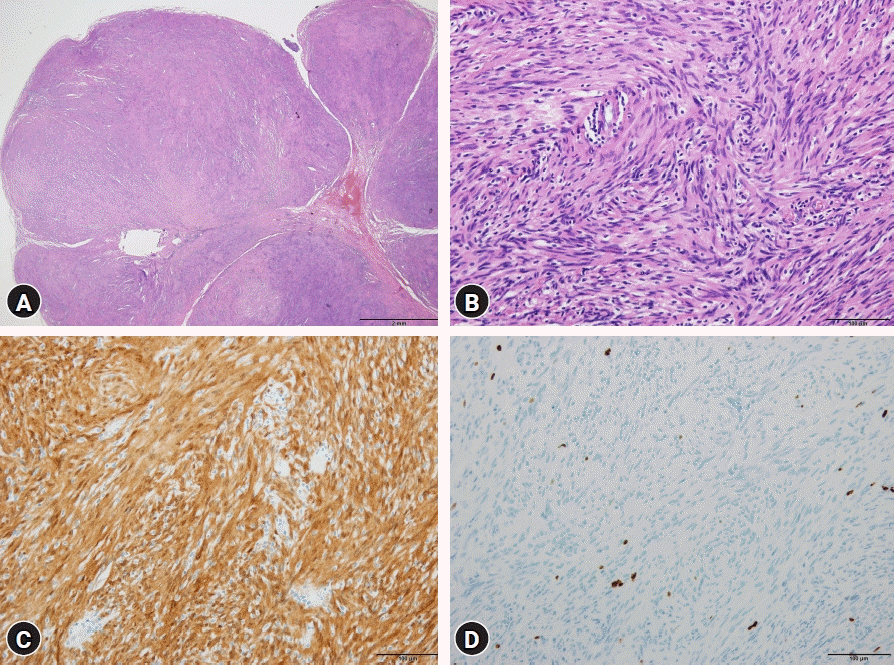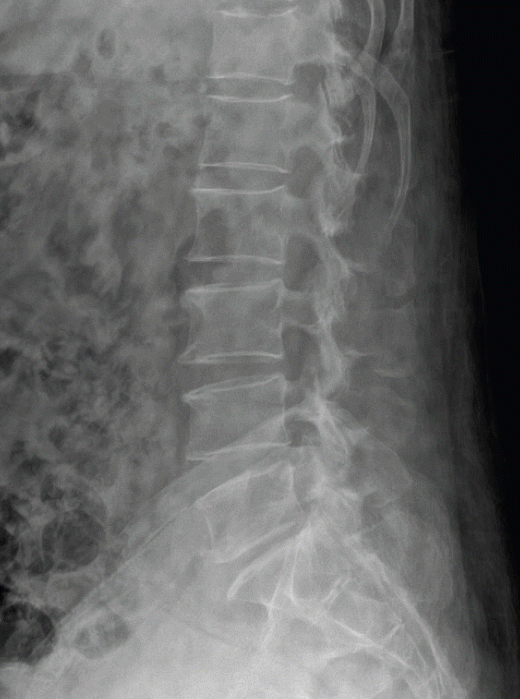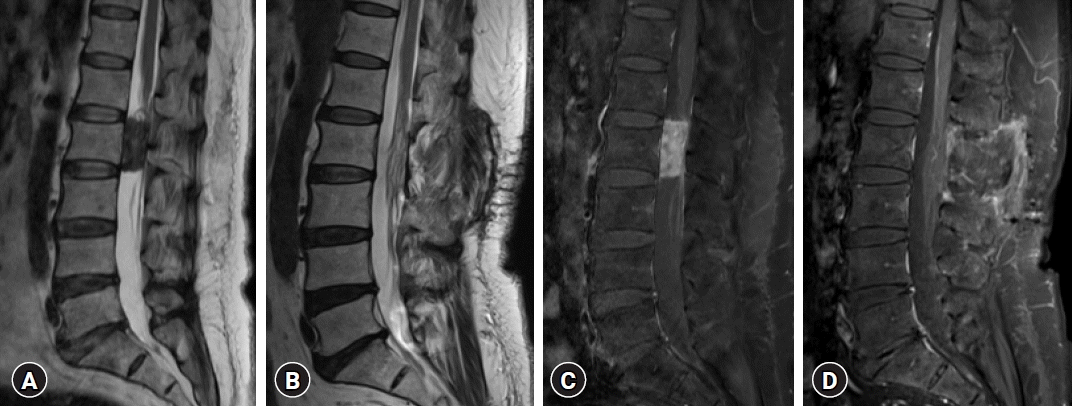Spinal Cellular Schwannoma: A Case Report of Acute Post-Traumatic Paralysis
Article information
Abstract
This case report describes a 64-year-old female patient who presented to the emergency department with lower back pain, bilateral leg pain, and numbness. Magnetic resonance imaging revealed a mass-like lesion at the L2 level, which was surgically removed and was found to be a cellular schwannoma upon histopathological examination. The patient exhibited immediate postoperative improvement and was referred for rehabilitation. This case highlights the importance of considering cellular schwannoma as a possible diagnosis in patients with intradural extramedullary tumors causing compressive symptoms.
INTRODUCTION
Cellular schwannomas are rare tumors that arise from Schwann cells, which form the myelin sheath surrounding the nerve fibers. Spinal cellular schwannomas are even rarer, accounting for only 1% to 10% of all spinal tumors 1,2). They typically present as slow-growing, well-circumscribed, intradural, extramedullary (IDEM) tumors arising from the spinal nerve roots. The symptoms include back pain, radicular pain, and sensory and motor deficits. The diagnosis of spinal cellular schwannomas is challenging because of their rarity and nonspecific clinical presentation5). Magnetic resonance imaging (MRI) is the most reliable diagnostic modality for IDEM tumors 2,8). Histopathological examination is the gold standard for diagnosis, which can differentiate cellular schwannomas from other IDEM tumors 3,8). Here, we describe the case of spinal cellular schwannoma, where the intradural extramedullary tumors were causing compressive symptoms.
CASE REPORT
A 64-year-old female patient with no significant medical history presented to the emergency department complaining of lower back pain, bilateral leg pain, and numbness. Two days before the presentation, the patient fell at home and began experiencing these symptoms. The pain worsened the following day and the patient sought emergency medical attention. Pain radiating along the L4 dermatome and she underwent a physical examination, which indicated the results of the straight leg-raising test to be 30° bilaterally. The sensory and motor functions were intact. Radiography showed no definite fracture or lesion; however, degenerative spondylosis and L5 disc space narrowing were observed (Fig. 1). The patient was suspected of having a ruptured disc or fracture. MRI of the lumbar spine revealed a mass-like lesion measuring approximately 3.4 cm, at the L2 level. This lesion was a relatively well-defined IDEM mass with low T1 and T2 signals and intense contrast enhancement (Fig. 2).

Radiological evaluation (magnetic resonance imaging). (A) T2-weighted, (B) T1-weighted, (C) T1 (contrast), showing a relatively well-defined intradural extramedullary mass with low-intensity T1 and T2 signals and intense contrast enhancement.
As leg weakness progressed to paralysis, emergency L2 total laminectomy with IDEM tumor removal was planned. Surgery was performed using a posterior midline approach, and a midline vertical skin incision was made at the L2 level. After L2 total laminectomy, an irregularly shaped tumor was observed adhering to the rootlet. The tumor was removed after separating it from the normal rootlet and dura mater. The rootlet adhering to the tumor could not be dissected and was sacrificed. After additional resection, total resection was performed. After sufficient irrigation, the dura mater was sutured to prevent hematoma accumulation. Histopathological examination was performed to rule out meningioma.
Grossly, the excised tissue revealed a lobulated, soft-to-rubber, solid mass with a thin capsule. The cut sections were grayish-yellow and grayish-white with focal ossification (Fig. 3). Microscopically, the tumor was composed of S-100 positive spindle cells with increased cellularity, which were arranged in short interlacing fascicles. Ki-67 staining revealed variable labeling indices (Fig. 4). It was confirmed to be a benign cellular schwannoma.

Gross section. The visual findings showed a lobulated, soft-to-rubbery solid mass with a thin capsule. The cut sections were grayish-yellow and grayish-white, with focal ossification.

Histopathological evaluation. (A) Hematoxylin and eosin (H & E) stain (×12.5 magnification) showing lobulated arrangement with increased cellularity. (B) H & E stain (×12.5 magnification) showing elongated and wavy spindle cells with tapered ends. (C) S-100 stain (×200 magnification) showing positive spindle cells with increased cellularity. (D) Ki-67 stain (×200 magnification) showing variable labeling indices.
The patient's pain improved from 7 of 10 on the numerical rating scale (NRS) before surgery to 3 of 10 after surgery. In terms of motor function, bilateral knee flexion/extension was grade-3, right ankle flexion/extension was grade-2, and left ankle flexion/extension was grade-1 just before surgery. On the fourth postoperative day, bilateral knee flexion/extension was grade-4, right ankle flexion/extension was grade-2, and left ankle flexion/extension was grade-4, showing an overall improvement. The patient was referred to the Department of Rehabilitation Medicine for rehabilitation therapy and was discharged. After 1 year of follow-up, the patient visited the outpatient clinic with slight pain and motor dysfunction (2 on the NRS and motor all grade-4), but no recurrence was observed on MRI of the lumbar spine (Fig. 5).
DISCUSSION
Cellular schwannomas are a rare type of benign nerve sheath tumors that arise from Schwann cells 7). Unlike conventional schwannomas that show a mix of hypercellular (Antoni A) and hypocellular (Antoni B) areas, cellular schwannomas are characterized by predominately Antoni A-type areas, contributing to higher cellularity. In addition, cellular schwannomas lack the characteristic Verocay bodies found in conventional schwannomas, and may display more nuclear atypia, appearing more aggressive under the microscope despite their benign nature 7,9,10). They are also slow-growing and may not show any indication until they grow large enough to compress nearby nerves or invade surrounding tissues 7). In the present case, a 64-year-old female patient with no significant medical history presented with lower back pain, bilateral leg pain, and numbness. Imaging revealed a mass-like lesion at the L2 level, which was later confirmed to be a benign cellular schwannoma.
The diagnosis of spinal cellular schwannomas can be challenging because they have variable imaging characteristics and mimic other spinal tumors 1,4). Pathologically, due to the high cellularity and arrangement of cells in short interlacing fascicles, cellular schwannomas may be mistaken histologically for more malignant entities such as fibrosarcoma or malignant peripheral nerve sheath tumors (MPNST) 10,11). However, these conditions exhibit different clinical behaviors and require different treatment strategies. MPNSTs, for example, are often associated with neurofibromatosis type 1 (NF1) and demonstrate aggressive behavior with a high propensity for local recurrence and distant metastasis, necessitating more radical surgical resection and often adjunctive therapies such as chemotherapy or radiotherapy11,12). Distinguishing cellular schwannomas from these malignant entities is important. However, the S-100 positive spindle cells found in our patient's tumor are a key differentiator. Fibrosarcomas and MPNST typically do not express the S-100 protein marker11). In the present case, gross pathological examination revealed a well-encapsulated, rubbery mass with a grayish-yellow and grayish-white appearance on cut sections, typical of cellular schwannomas due to the high cellularity and presence of xanthomatous cells. In imaging studies, the tumor appeared as a well-defined IDEM mass with low T1 and T2 signals and intense contrast enhancement on MRI, which is consistent with previous reports. However, contrast-enhanced MRI was performed to evaluate the tumor, highlighting the importance of multiple imaging modalities in diagnosing spinal tumors 8).
Spinal cellular schwannomas are surgically completely resectable 6). In the present case, an emergency L2 total laminectomy with IDEM tumor removal was performed. The tumor was completely removed successfully. The patient's symptoms and motor function improved immediately after surgery. These findings are consistent with previous reports of favorable outcomes following surgery for spinal cellular schwannomas 5).
In conclusion, spinal cellular schwannomas are rare but should be considered in the differential diagnosis of spinal tumors 4). Imaging studies, including contrast-enhanced magnetic MRI, can aid in the diagnosis of these tumors. Complete resection is required, and favorable outcomes can be expected with complete resection 1,5,6,8).
Notes
No potential conflict of interest relevant to this article was reported.

